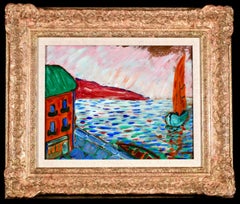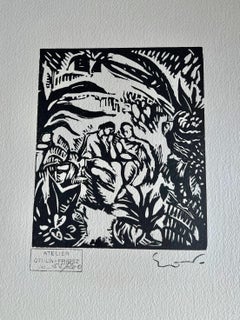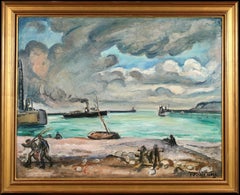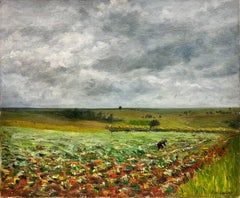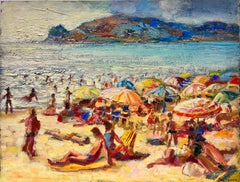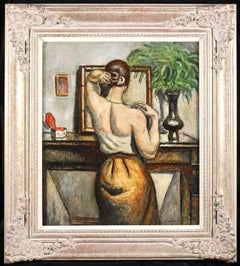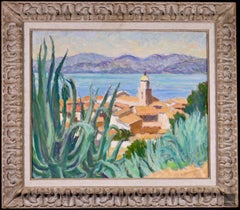Achille-Émile Othon Friesz Figurative Paintings
French, 1879-1949
Othon Friesz was a native of Le Havre France 1879-1949. He was a French artist of the Fauvist movement. He was a good friend of Raoul Dufy and met Matisse, Marquet and Rouault and exhibited with them in 1907. In his later years he painted in a style very different than his earlier years. He respected Cezanne's style of logical composition, simple tonality, solidity of volume and distinct separation of planes and a baroque flavor to his style. He is known for Fauve and traditional painting, landscapes, still lifes and figurative style. He admired the works of modernists. Hi works are in major museums throughout the world.to
1
1
1
1
Overall Width
to
Overall Height
to
3
1
1
3
2
1
2
1
1
1
1
2
2
1
1
1
11
462
327
258
219
2
2
1
Artist: Achille-Émile Othon Friesz
Etude Barque au Quai - Normandy - Post Impressionist Seascape Oil - Othon Friesz
By Achille-Émile Othon Friesz
Located in Marlow, Buckinghamshire
Signed oil on paper laid on panel seascape c.1907 by French post impressionist painter Achille-Emile Othon Friesz. The piece is a study of a view of a boat in a quay at Normandy, Fra...
Category
Early 1900s Post-Impressionist Achille-Émile Othon Friesz Figurative Paintings
Materials
Oil, Panel, Laid Paper
un couple pensif
By Achille-Émile Othon Friesz
Located in Belgrade, MT
This woodcut black and white is part of my private collection. It is in very good condition. It is artists signed in the lower right and numbered o the left. Atelier Othon-Friesz
Category
Early 20th Century Fauvist Achille-Émile Othon Friesz Figurative Paintings
Materials
Lithograph, Woodcut
$360 Sale Price
40% Off
Port of Le Havre & Sainte-Adrese- Post Impressionist Seascape Oil - Othon Friesz
By Achille-Émile Othon Friesz
Located in Marlow, Buckinghamshire
Signed and dated oil on canvas seascape by French post impressionist painter Achille-Emile Othon Friesz. The piece depicts a view of Le Havre, a port city in Normandy, France, locate...
Category
1920s Post-Impressionist Achille-Émile Othon Friesz Figurative Paintings
Materials
Canvas, Oil
Related Items
Mid Century French Post Impressionist Oil on Canvas Man Working in Fields
By Josine Vignon
Located in Cirencester, Gloucestershire
Working in the Fields
by Josine Vignon (French 1922-2022)
signed and stamped verso
oil painting on canvas, unframed
canvas: 21 x 26 inches
very good condition
provenance: from the a...
Category
Mid-20th Century Post-Impressionist Achille-Émile Othon Friesz Figurative Paintings
Materials
Canvas, Oil
$1,640
H 21 in W 26 in D 1 in
20th French Post Impressionist Oil Busy Summer Beach Scene Many Figures & Color
By Josine Vignon
Located in Cirencester, Gloucestershire
Sur la Plage
by Josine Vignon (French 1922-2022)
signed lower right
oil painting on canvas, unframed
canvas: 20 x 25.5 inches
Colors: Yellow gold and warm colors, red, blue and ora...
Category
Mid-20th Century Post-Impressionist Achille-Émile Othon Friesz Figurative Paintings
Materials
Canvas, Oil
Josine Vignon20th French Post Impressionist Oil Busy Summer Beach Scene Many Figures & Color, 1960's
$3,295
H 20 in W 25.5 in D 1 in
Brown Still Life from Chagall by Jacques Lassaigne
By Marc Chagall
Located in Washington, DC
Artist: Marc Chagall
Medium: Lithograph
Title: Brown Still Life
Portfolio: Chagall by Jacques Lassaigne
Year: 1957
Edition: 6,000
Framed Size: 13 3/4" x 15 1/2"
Sheet Size: 9" x 7 3/...
Category
1950s Fauvist Achille-Émile Othon Friesz Figurative Paintings
Materials
Lithograph
Emile Chaumont (1877-1927) - Summer landscape in Dordogne
Located in BELEYMAS, FR
Emile CHAUMONT
(Perigueux 1877 - 1927)
Summer landscape in Périgord
Oil on panel
H. 32 cm; L. 41 cm
Signed lower left, dated 1912
Provenance: Private c...
Category
1910s Post-Impressionist Achille-Émile Othon Friesz Figurative Paintings
Materials
Oil, Panel
$1,445
H 12.6 in W 16.15 in
"Arc de Triomphe" Post-Impressionist Parisian Nocturne Street Scene Oil Painting
By Louis van der Pol
Located in New York, NY
Louis Van Der Pol (Dutch, 1896-1982) was active in the 20th Century and lived in Holland. He was known for his large format elaborate romantic portrait paintings and city street scen...
Category
Mid-20th Century Post-Impressionist Achille-Émile Othon Friesz Figurative Paintings
Materials
Oil, Wood Panel
$2,500
H 14.5 in W 17 in D 2 in
Grenade et Pipe from the Espace Portfolio
By Georges Braque
Located in Kansas City, MO
Georges Braque (after)
Title: Grenade et Pipe from the Espace Portfolio
Year: 1957
Year of Original: 1932
Medium: Pochoir (pigment print) on Richard de Bas, signed in the plate
Edit...
Category
1950s Fauvist Achille-Émile Othon Friesz Figurative Paintings
Materials
Pigment
Matisse, Découpage, Société internationale d'art XXe siècle (after)
By Henri Matisse
Located in Southampton, NY
Lithograph on vélin paper. Paper Size: 12.4 x 9.65 inches. Inscription: Signed in the plate and unnumbered, as issued. Notes: From the album, XXe siècle, Nouvelle série N°4 (double) ...
Category
1950s Fauvist Achille-Émile Othon Friesz Figurative Paintings
Materials
Lithograph
$956 Sale Price
20% Off
H 12.4 in W 9.65 in
"Parisian City Street Scene" Town & Figures Mid-20th Century Oil Painting Canvas
Located in New York, NY
This painting depicts a colorful Mid Century Street in Paris France, a popular subject of the times painted by many important impressionist 20th Century painters. This piece is a bol...
Category
Mid-20th Century Post-Impressionist Achille-Émile Othon Friesz Figurative Paintings
Materials
Oil, Canvas, Panel
$800
H 13.5 in W 15.5 in D 1 in
Edouard Léon Cortès, Oil on Wood Panel, "Notre-Dame View from The Quays, 1936"
By Édouard Leon Cortès
Located in Madrid, ES
EDOUARD LÉON CORTÈS
French, 1882 - 1969
NOTRE-DAME VIEW FROM THE QUAYS
signed "EDOUARD CORTÈS." (lower right); inscribed "6728" au crayon bleu et cachet "...
Category
1930s Post-Impressionist Achille-Émile Othon Friesz Figurative Paintings
Materials
Wood Panel, Oil
Vlaminck, Nature morte aux pommes, Vlaminck (after)
By Maurice de Vlaminck
Located in Southampton, NY
Lithograph in fifteen colors on vélin paper. Inscription: Signed in the plate and unnumbered, as issued. Paper Size: 12.25 x 9.5 inches; image size: 6.7 x 8.3 inches. Notes: From the...
Category
1950s Fauvist Achille-Émile Othon Friesz Figurative Paintings
Materials
Lithograph
Huge 20th Century French Fauvist Oil Painting Sunny Hot Market Scene & Town
Located in Cirencester, Gloucestershire
The French Market
by Michel Kritz (French 1925-1994)
oil on canvas, unframed
canvas: 24 x 32 inches
provenance: private collection, France
condition: very good and sound condition
Category
Mid-20th Century Fauvist Achille-Émile Othon Friesz Figurative Paintings
Materials
Canvas, Oil
Huge 1970's French Oil Painting Figurative Oil Painting Workers on Scaffolding
Located in Cirencester, Gloucestershire
Figurative Oil Painting of Workers on Scaffolding
French artist, circa 1970's
oil on canvas, unframed
canvas : 51 x 38 inches
Provenance: private c...
Category
Mid-20th Century Post-Impressionist Achille-Émile Othon Friesz Figurative Paintings
Materials
Oil, Canvas
Previously Available Items
Nu dans un miroir - Post Impressionist Figurative Oil Painting by Othon Friesz
By Achille-Émile Othon Friesz
Located in Marlow, Buckinghamshire
Signed figure in interior oil on canvas circa 1920 by French post impressionist painter Achille-Emile Othon Friesz. The piece depicts a woman standing at...
Category
1920s Post-Impressionist Achille-Émile Othon Friesz Figurative Paintings
Materials
Canvas, Oil
Vue de Saint Tropez - Post Impressionist Oil, Coastal Landscape by Othon Friesz
By Achille-Émile Othon Friesz
Located in Marlow, Buckinghamshire
Signed and dated oil on canvas coastal landscape by French post impressionist painter Achille-Emile Othon Friesz. The piece depicts a view of Saint Tropez from a hill looking out over the red roofs of the town and the blue sea beyond. Mountains can be seen in the distance.
Signature:
Signed and dated 1925 lower right
Dimensions:
Framed: 25"x29"
Unframed: 18"x22"
Provenance:
This work was authenticated by Robert Martin author of the catalogue raisonne on the 1st Feb 1994 and is included in the archives of the painter managed by Mme. Odile Aittouarès
Christies - London, 28 June 1994 - Impressionist & Modern Paintings - Lot 394
Achille Friesz was the son of a family of sailors from Le Havre. From 1885 he often spent time in Marseilles visiting his maternal uncles. As a child he dreamed of going to sea, but from the age of 12 he developed a passion for art, and after secondary school he attended the École des Beaux-Arts in Le Havre. There, from 1896 to 1898, he studied under Charles-Marie Lhullier who had been a friend of Jongkind and whom, like Dufy and Braque, he remembered fondly throughout his life. Lhullier introduced his students to the work of Chardin, Corot, Géricault and Delacroix. After receiving a bursary from the local authorities in 1898, he went to Paris and, while his friends Matisse, Rouault and Marquet studied under Gustave Moreau, enrolled at the École des Beaux-Arts at the studio of Léon Bonnat, where he was joined by Dufy. However, he scarcely attended the studio, preferring to go to the Louvre and make copies of the works of Clouet, Veronese, Rubens, Claude Lorraine and Delacroix. He did his military service in Paris in 1902 but continued with his art. Around this time he met Camille Pissarro and sought his advice. As a young man he began to make frequent trips away, not necessarily travelling very far, but looking for subjects for his work, usually landscapes. Among the places he visited were the Creuse region around 1903, Antwerp in 1905, returning there with Braque in 1906, and La Ciotat, Cassis and L'Estaque in 1906-1907, again in the company of Braque. In Paris he frequently moved lodgings until 1914. He moved in with Henri Matisse at the Couvent des Oiseaux from 1905-1910, that is to say at the period when Fauvism was at its height. In 1908 he returned to his native Normandy to reimmerse himself in his early environment; he would return to the region throughout his life. He made a trip to Munich with Dufy in 1909, and visited Portugal in 1911-1912 and Belgium in 1912. In 1914 he was called up and assigned to technical services, not being demobilised until March 1919, although he did manage to maintain a certain independence. From 1914 until his death he lived in Paris at 73 Rue Notre-Dame-des-Champs, where he occupied Bouguereau's old studio. He made frequent trips to Cap-Brun near Toulon where, in 1923, he acquired a property called Les Jarres, as well as making numerous visits to Normandy and Le Havre. In 1925 he received the highest commendation at the Carnegie Prize in Pittsburgh for Portrait of the Decorative Artist Paul Paquereau. Also in 1925, at the same time as Matisse, he was made a Chevalier of the Légion d'Honneur, rising to in Officier in 1933 and Commandeur in 1937. He was also made Commander of the Swedish order of Vasa in 1934. Throughout his life, Friesz was a teacher: from 1913 at the Académie Moderne; from 1929 at the Académie Scandinave; and from 1941 until his death at the Académie de la Grande-Chaumière. Alongside his activity as a painter, he illustrated several works of literature, including: in 1920 Le Pacte de l'Écolier Juan by Jules Tellier; in 1924 Échelles de Soie by Jean Pédron; in 1926 Le Jardin sur l'Oronte by Maurice Barrès; in 1926 En Suivant la Seine by Gustave Coquiot; in 1929 Rouen by André Maurois; in 1931 The Song of Songs; in 1934 Poésies by Pierre de Ronsard; in 1945 Le Bouquet de la Mariée by Gabriel-Joseph Gros; in 1947 Paul et Virginie by Bernardin de St-Pierre; in 1949 Le Livre de Job by Pierre Poussard; in 1949 Petronius's Satyricon, and in 1949 a collection of 12 unpublished lithographs for Le Désert de l'Amour by François Mauriac. He also designed several pieces of decorative art: from 1906 to 1909 ceramics executed by Metthey among others; a façade for a private house in Le Havre; a china service for two for the Le Havre writer J.-G. Aubry; vases, dishes and plates; in 1912 four sets for La Lumière by Georges Duhamel, performed at the Odéon; in 1916 a screen for the Le Havre collector Léon Pédron; in 1918 panels for Pédron's dining room; in 1920 a mural entitled Children Dancing (Enfants Dansant); in 1920 Les Volières for the apartment of Vicomte Amédée de Flers; in 1935 Peace (La Paix), a Gobelins tapestry presented by France to the Palais des Nations in Geneva; in 1937 La Seine in collaboration with Dufy for the Palais de Chaillot, with each artist taking half of the river's course - From the Source to Paris by Friesz and From Paris to the Estuary by Dufy. The Fauves were producing Fauve paintings before they knew it: it was not until the critic Louis Vauxcelles saw their work at the Salon des Indépendants in 1905 and mockingly used the word Fauve to describe it that the term was born. It is known that Vlaminck and Derain worked together and that the École de Chatou was composed of just these two artists. Friesz was living with Matisse and after his first trip to Antwerp in 1905, he returned in 1906 with Braque. In 1906-1907 Friesz and Braque went to La Ciotat to paint and there they met up with Matisse. The paintings Friesz produced in Antwerp are Fauve inasmuch as they are painted in pure colours and are more or less free of the divisionism of the Impressionists, although the draughtsmanship is fairly standard; these works include The Port, The Escaut, The Canals, The Dock with Sailing Ships and The Red Slipway. Those of Braque the following year, in particular Terrace on the Escaut, show great similarities with those Friesz painted of the same subject. Friesz was already avoiding the hardness of pure flat tints by graduating them in thin glazes, allowing the whiteness of the canvas to penetrate the transparency, a technique that came to characterise his entire Fauve period. At La Ciotat Friesz and Braque adopted completely different Fauve styles, with Braque composing his paintings on horizontal and vertical orthogonals painted in small, regular, spaced-out touches, whereas Friesz developed his own personal rhythmical style of wide arabesques of colour in works such as The Bec-de-l'Aigle, Women Bathing and L'Estaque. Many of Friesz's Fauve works were produced in the south of France, and his Portrait of Fernand Fleuret also dates from this period. When he returned to Normandy in 1908 the period that he described as his 'return to form' began; with compromise paintings such as Entrance to the Port of Honfleur, Côte de Grâce Landscape, The 'Bains Marie-Christine' in Le Havre and the great compositions characteristic of this period - Autumn Labours, Spring, Fisherman on a Rock and Women Bathing. His draughtsmanship retains something of the rhythm of the Fauve period, his figures following the lines of the landscape and the colour remaining clear and resonant. In 1909 he painted the Cirque Médrano series: The Trapeze Artist, The Clown and The Horsewoman. In the south of France he also painted the Olive Trees series. He made a trip to Munich with Raoul Dufy resulting in Winter in Munich. This was also the year of his first trip to Italy. Boat in a Rocky Inlet of 1910 marks one of the pivotal points between a totally rhythmic drawing style of sensual curves typical of his Fauve period and a reduced palette of muted ochres, browns and blues. From 1910 onwards, the final traces of Fauvism become less and less apparent in his work. His use of colour follows the same course, towards the transcription of reality, with broken tones, ochres and browns. After his demobilisation, as well as in his studio in Paris, Friesz spent time in his house in Toulon, returned to Normandy and Le Havre and continued to make frequent, often local, forays in search of new subjects: in 1919 to Jura, producing the series Forests, Pine Trees, Road in the Snow and Invitation to Skate; in 1920 to Italy producing Piedmont Village, Florence Grape Pickers; in 1920 to Le Havre, producing The Étretat Cliffs, People Bathing at Étretat; in 1923 to his house in Toulon, producing View of Coudon, Women Bathing, Grape Harvesting, Jars; in 1924 he painted the Large Nude (which he exhibited at the Salon d'Automne the same year) and landscapes of Toulon; in 1928 he made a trip to Algiers, producing The Algiers Kasbah and its Phantoms; in 1931 to Annecy, producing Women Bathers by a Lake; in 1934-1935 to Dinan and St-Malo producing The Great Dinan Viaduct, The Dock with the Terre-Neuvas, After Bathing; in 1936 to Honfleur; in 1941-1944, remaining in Paris because of the war, he painted mainly still-lifes, including Studio Corner, Earthenware. In 1946 he returned to Honfleur; and in 1947 to La Rochelle producing The Port Tower, Tuna Boats, The Red Sail. Numerically Friesz's work is dominated by landscapes but it should be remembered that throughout his career he tackled more ambitious compositions and appeared to do so with great ease. These include Boat in a Rocky Inlet of 1910 with its frolicking women bathers, Allegory of War of 1915 executed in 24 hours, Invitation to Skate of 1919, numerous paintings of Women Bathing over several periods and much later Women beside a Pond of 1944, which clearly demonstrates his attachment to Cézanne. He exhibited at the Salon des Artistes Français from 1901 to 1903 and then at the Salon des Artistes Indépendants. From 1906 he exhibited annually at the Salon d'Automne, of which he later became a committee and jury member. In 1923 he took part in the founding of the Salon des Tuileries and became head of two of the Salon's sections. His work has been exhibited at countless group exhibitions all over the world. Among the most recent thematic exhibitions is Fauvism in Black and White. From Gauguin to Vlaminck, Fauvist Engraving and its Setting (Le Fauvisme en Noir et Blanc. De Gauguin à Vlaminck, l'Estampe des Fauves et son Environnement) at the Musée d'Art Moderne in Villeneuve d'Ascq in 2001. He also showed his work in numerous solo exhibitions in Paris: his first in 1904 at the Galerie des Collectionneurs and another the same year at the Société des Peintres du Paris Moderne...
Category
1920s Post-Impressionist Achille-Émile Othon Friesz Figurative Paintings
Materials
Canvas, Oil
Achille-émile Othon Friesz figurative paintings for sale on 1stDibs.
Find a wide variety of authentic Achille-Émile Othon Friesz figurative paintings available for sale on 1stDibs. You can also browse by medium to find art by Achille-Émile Othon Friesz in canvas, fabric, oil paint and more. Much of the original work by this artist or collective was created during the 20th century and is mostly associated with the Post-Impressionist style. Not every interior allows for large Achille-Émile Othon Friesz figurative paintings, so small editions measuring 24 inches across are available. Customers who are interested in this artist might also find the work of Victor Charreton, Lucien Adrion, and Georges Henri Manzana Pissarro. Achille-Émile Othon Friesz figurative paintings prices can differ depending upon medium, time period and other attributes. On 1stDibs, the price for these items starts at $23,044 and tops out at $28,817, while the average work can sell for $25,930.
